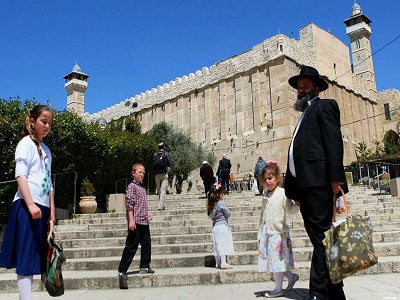
Israeli occupation authorities have intensified the restrictions imposed on Palestinian residents of Hebron, according to an update by UN OCHA.
A new fence installed by Israeli occupation forces around two Palestinian neighbourhoods in the so-called “H2” area of the city, As Salaymeh and Gheith, has further separated up to 1,800 Palestinians from the rest of the city.
According to UN OCHA, this latest measure “is in addition to the recent reinforcement (including the instalment of turnstiles) of two pre-existing checkpoints controlling access to the area where the new fence was installed”.
Settlers harass Palestinians in Tel Rumeida. Then the army arrests and mistreats the Palestinians. Filmed by Nour Abu Aisha pic.twitter.com/MaZBHhYFKy
— YouthAgainstSettlmnt (@YASHebron) October 13, 2017
Such developments “disrupt the livelihoods and family life of Palestinians living in the two neighbourhoods and limit access to basic services like health and education”.
In May 2017, UN OCHA relates, Israel installed an approximately 50 metre-long and 1.5-metre-high metal bar fence on top of concrete slabs, with a gate, next to a metal fence initially installed in 2012 to surround As Salaymeh and Gheith. “According to residents, Israeli Border Police manning the gate close it irregularly, without prior notice, leaving residents in a state of constant uncertainty”.
Meanwhile, the main street behind the fence is used by Israeli settlers from Kiryat Arba settlement to access the Ibrahimi Mosque on foot or by car; however, “Palestinian vehicular movement along this street is prohibited”.
a 7-year-old Palestinian girl was hospitalised after settlers threw stones at her family's car in Hebron, in the occupied West Bank pic.twitter.com/PtmVsmGwYM
— Haddad1310 (@martyrs177) October 8, 2017
Some 600 children enrolled in schools outside the restricted area regularly use alternative routes between houses and alleys. This can add 1.5km to their journey “and exposes them to friction with Israeli settlers and soldiers”.
The fortification of two checkpoints in mid-2016 already hampered the entry of commodities into the As Salaymeh and Gheith neighbourhoods, and to other neighbourhoods in the settlement-affected area of the city.
“Other measures have been imposed at these checkpoints”, reports UN OCHA, “such as prohibiting men under 40 from entering on Fridays: a measure which was first implemented in 2015 and has become systematic since May 2016”.
Additional Hebron street divided for Jewish holiday – one side for Israeli settlers, one side for Palestinians #SegregatedAndUnequal pic.twitter.com/hkobu05INM
— YouthAgainstSettlmnt (@YASHebron) October 10, 2017
The H2 area includes four Israeli settlement compounds, home to a few hundred Israeli settlers and a population of over 40,000 Palestinians. 30 per cent of the Palestinians living in H2 reside in neighbourhoods adjacent to the settlement compounds and are affected by strict access restrictions.
Currently, there are over 100 physical obstacles, including 20 permanently staffed checkpoints and 14 partial checkpoints that separate the settlement area from the rest of the city. Several streets within this area are designated for the exclusive use of settlers and are restricted for Palestinian traffic. In some streets, Palestinian pedestrians are banned.
(MEMO, PC, Social Media)






Israel is planning on taking over those neighborhoods by making life so unbearable that the palastinian people will leave.